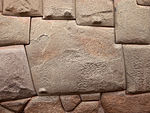
A maloca is an ancestral long house used by indigenous people of the Amazon, notably in Colombia and Brazil.[1] Each community has a single maloca with its own unique characteristics.[2] Several families with patrilineal relations live together in a maloca, distributed around the long house in different compartments. In general, the chief of the local descent group lives in the compartment nearest to the back wall of the long house. As well, each family has its own furnace.
During festivals and in formal ceremonies, which involve dances for males, the long house space is rearranged; the centre of the long house is the most important area where the dance takes place. Each maloca has two entrances, for men and for women. Married men and women sleep together, and unmarried men sleep separately, as do unmarried women. A maloca is traditionally surrounded with two gardens: the inner called the kitchen gardens (growing plants such as bananas, papaya, mango and pineapple) and the manioc gardens growing manioc (yuca).
See also
[edit]- Maloca is also a synonym for malón, a Mapuche raid.
- Jesuit Missions of Chiquitos, partly inspired by indigenous architecture
References
[edit]- ^ Gutierrez, Maria Paz (March 2020). "The Northwestern Amazon malocas: Craft now and then". Journal of Material Culture. 25 (1): 3–35. doi:10.1177/1359183519836141. ISSN 1359-1835. S2CID 150987018.
- ^ Goldman, Irving (1979). The Cubeo Indians of the Northwest Amazon. University of Illinois Press. ISBN 978-0-252-00770-5.
External links
[edit]- La Maloca de los Sabedores de Oscar Freire


Well, that’s interesting to know that Psilotum nudum are known as whisk ferns. Psilotum nudum is the commoner species of the two. While the P. flaccidum is a rare species and is found in the tropical islands. Both the species are usually epiphytic in habit and grow upon tree ferns. These species may also be terrestrial and grow in humus or in the crevices of the rocks.
View the detailed Guide of Psilotum nudum: Detailed Study Of Psilotum Nudum (Whisk Fern), Classification, Anatomy, Reproduction